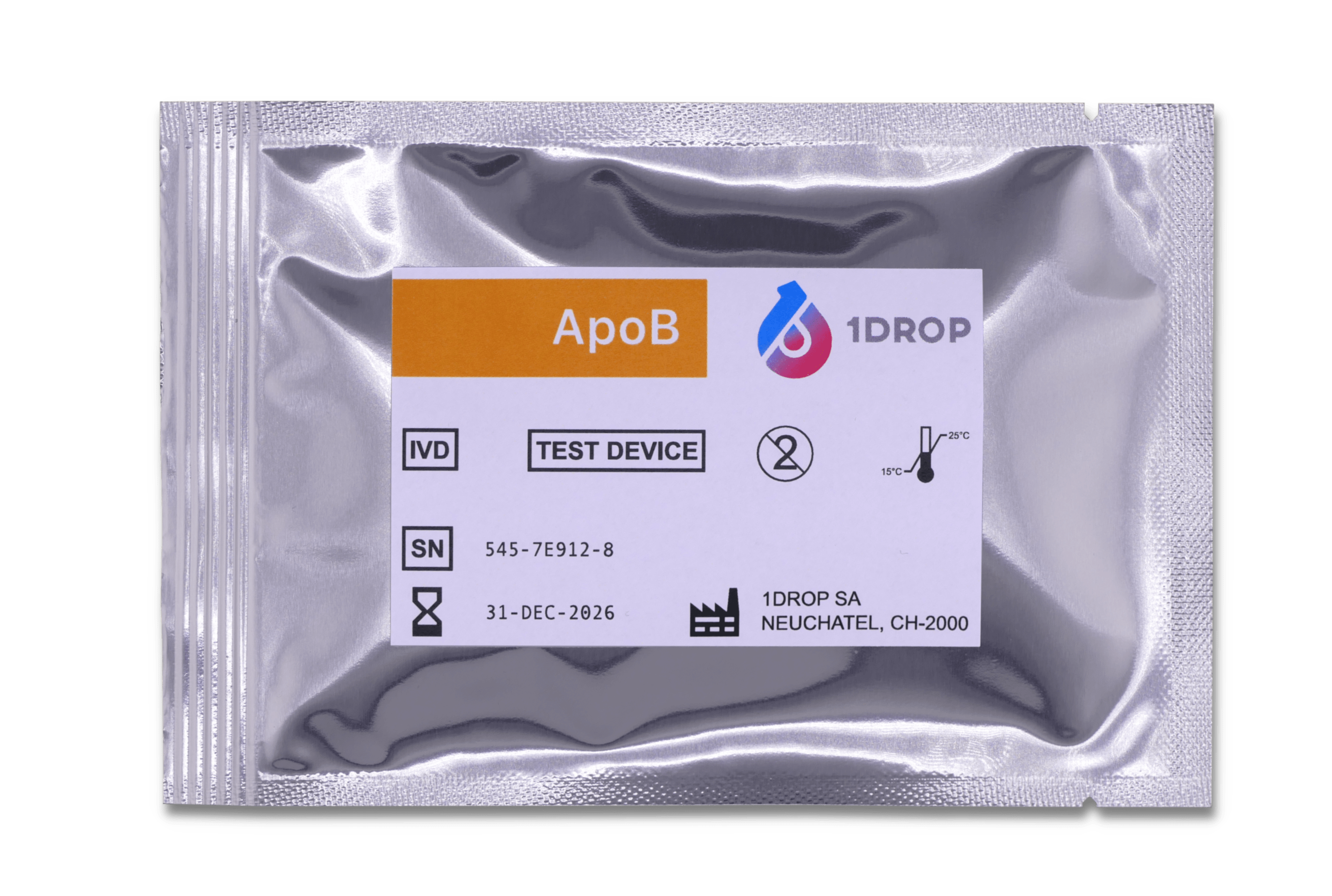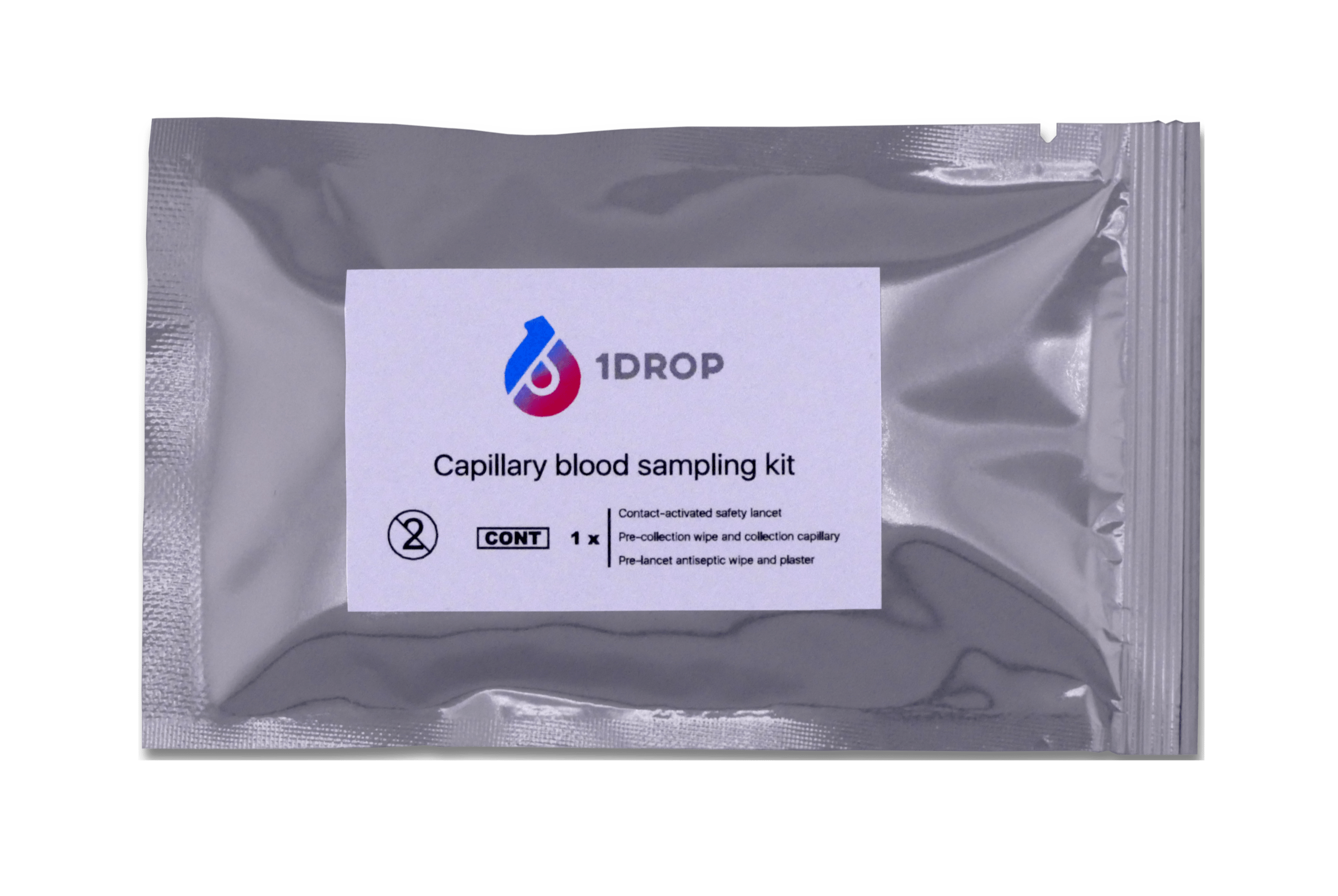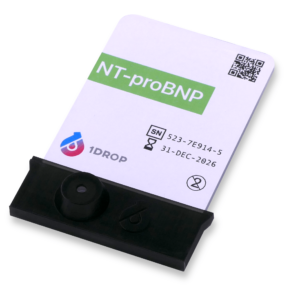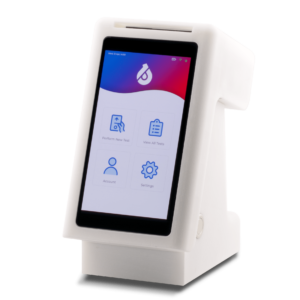Apolipoprotein B (ApoB)
CHF 59.00
The Apolipoprotein B (ApoB) Test assesses buildup of plaque in the arteries (atherosclerosis) and the risk of developing cardiovascular disease (CVD). Monitor the effectiveness of lifestyle changes or medications aimed at reducing cholesterol.
This is a pre-order product. We plan FDA 510(k) Clearance in North America and CE Mark in Europe in Q4 2024. We plan to start shipping in Q1 2025.
Capillary Blood Sample
Finger prick collection
Age 18+
10 minutes time to result
About the test
The Apolipoprotein B (ApoB) Test measures the amount of ApoB in blood. ApoB is a protein that plays a critical role in lipid metabolism, specifically in the transport of cholesterol and lipids in blood.
Elevated levels of ApoB have been linked to an increased risk of CVD, as it can contribute to the buildup of plaque in the arteries. ApoB is found in two main forms: ApoB-100, which is primarily produced by the liver and is found in low-density lipoprotein (LDL) cholesterol, and ApoB-48, which is found in chylomicrons (lipoproteins that transport dietary lipids).
The ApoB test is used to assess the risk of developing CVD. The test may be particularly useful in individuals who have normal or slightly elevated levels of LDL cholesterol, but still have a high risk for heart disease due to other risk factors, such as a family history of heart disease or diabetes.
In addition, the ApoB test may be used to monitor the effectiveness of lifestyle changes or medications aimed at reducing cholesterol levels. Some studies have suggested that ApoB may be a better predictor of cardiovascular risk than LDL cholesterol, particularly in people with diabetes or metabolic syndrome.
Who should take this test
This test is suitable if you:
- Would like to assess your risk of developing CVD
- Have normal or slightly elevated levels of LDL cholesterol
- Are at risk of CVD and would like to learn more
- Have a family history of CVD, hyperlipidemia (high cholesterol and triglycerides) or diabetes
- Would like to evaluate the effectiveness of lifestyle changes, such as dietary modifications and exercise, or medications at lowering cholesterol levels.
This test is not suitable if you:
- Have a history of liver or kidney disease or other conditions that can affect lipid metabolism and ApoB levels in the blood
- Are taking medications that can affect lipid metabolism, such as steroids or thyroid medications
- Are pregnant or breastfeeding, as pregnancy and lactation can affect lipid metabolism and ApoB levels
What’s tested
First, it’s necessary to understand lipid metabolism and cholesterol. Cholesterol is a type of fat that is essential for human life and used by cells as a building block for hormones and a structural material (cell membranes, nerve cell insulation). Although every cell can create its own cholesterol, it is mostly produced by the intestines and liver. Transporting cholesterol through the bloodstream poses a problem because it is hydrophobic, it does not like water, and thus it does not dissolve in blood. To solve this issue, cholesterol is enclosed by a hydrophilic shell called a lipoprotein to allow it to travel in small particles.
Different types of lipoproteins transform into each other as they release triglycerides. Very Low-Density Lipoprotein (VLDL) is the initial molecule in this series. VLDL is created when the liver bundles cholesterol with triglycerides into a protein-wrapped molecule that floats in the bloodstream. VLDLs release triglycerides into cells that can store them or use them for immediate energy. After losing some mass, VLDLs become Intermediate Density Lipoproteins (IDL), which return to the liver and removes about half from circulation. The remaining IDLs undergo hydrolysis and become Low-Density Lipoproteins (LDL) that carry a high concentration of cholesterol. LDLs circulate until they encounter a cell with an LDL receptor, at which point they are absorbed and broken down. When stored cholesterol passes a certain threshold, the cell slows its production of cholesterol and new LDL receptors, making it harder for LDL particles to deposit cholesterol and raising circulating LDL levels. Lipoprotein(a) or Lp(a) is a variant of LDL with an unknown biological purpose but may aid in wound healing and tissue repair.
The lipoproteins VLDL, IDL, LDL, and Lp(a) are all atherogenic and can cause serious cardiovascular disease. LDL is often referred to as “bad cholesterol” due to being the most abundant and atherogenic. When lipoproteins breach the walls of arteries, they start an inflammatory process, attracting macrophages to clear the waste. When there is too much cholesterol to clear, the macrophages are overwhelmed and can become “foam cells”, accumulate and cause build up arterial plaques. Eventually, these plaques can block blood vessels and lead to heart attacks or strokes. Lp(a) can accelerate this process by increasing inflammation. On the other hand, HDL, often referred to as “good cholesterol”, is not atherogenic and does not carry an ApoB protein. This is useful because the ApoB Tests can track atherogenic lipoproteins without including neutral or potentially beneficial HDL particles.
The ApoB Test can help in assessing a person’s risk for atherosclerosis and heart disease. Research has shown that ApoB is a better indicator of risk of developing CVD than LDL cholesterol.
Signs and Symptoms
There are often no signs or symptoms associated with high cholesterol or ApoB. However, it can significantly raise the risk or a heart attack or stroke. A blood test is the sole definitive method of knowing whether a person has high levels of cholesterol or ApoB.
Some people may experience symptoms related to cardiovascular disease, which can be caused by high cholesterol or ApoB. If you are experiencing any of these symptoms, SEEK MEDICAL ASSISTANCE IMMEDIATELY:
- Shortness of breath
- Chest pain or discomfort
- Pain or weakness in one or both arms
- Pain in the back, neck, jaw, or stomach
- Difficulty speaking
- Vision problems
- Dizziness or lightheadedness
- Symptoms associated with stroke such as face drooping, numbness, or confusion
Eligibility
The ApoB Test is available for anyone over the age of 18 who wishes to measure their ApoB to evaluate their risk of CVD.
Before your Test
No special preparation is needed for this test. However, since this test is often performed with tests that require fasting, such as LDL, HDL cholesterol and triglycerides, fasting may be required for at least 12 hours.
After your Test
Your test results will be available in the 1DROP App and patient portal on the website, tablet or computer. You will receive a comprehensive and easy-to-understand report. You will be alerted if your results are outside the normal ranges.
Interpret the Results
In general, a lower ApoB level is considered beneficial, but there is still debate on the ideal cutoff point for determining risk of CVD.
The clinical guidelines of the American College of Cardiology and the American Heart Association consider ApoB above 130 mg/dL a “risk-enhancing factor” for atherosclerotic cardiovascular disease. Some groups have set more aggressive ApoB targets for people who are at a higher risk of developing heart disease. For example, the American Diabetes Association and the American College of Cardiology Foundation recommend an ApoB target of less than 90 mg/dL for people at risk of heart disease (diabetes). For those who are at even higher risk, such as those who already have heart disease, the recommendation is an even lower target of less than 80 mg/dL. Medscape recommends a ceiling of 130 mg/dL for low-risk patients, 110 mg/dL for moderate-risk patients, and 90 mg/dL for high-risk patients.
| Apolipoprotein B Reference Range | |
| Desirable | <90 mg/dL |
| Borderline High | 90 – 99 mg/dL |
| High | 100 – 130 mg/dL |
| Very High | >130 mg/dL |
HOW IT WORKS
Order online test anywhere

Choose Your Tests
Shop for tests on the 1DROP website or App. Order your tests and they will be shipped to you.

Test Your Sample
Insert the Chip into the Reader. Collect a finger prick of blood and place it on the Chip. The 1DROP Reader analyzes your sample within 15 minutes.

View Your Results
View your test results on the secure and private patient portal on your smartphone, tablet or computer. Easily share your results with your doctor, family, friends. Obtain guidance on your next steps.
BENEFITS
Take control of your health
Easy, rapid, affordable home testing
Convenient and Fast
Easy to Use and Understand
Personalized
Reduce Preanalytical Error
Private & Secure
Actionable Health Information
QUESTIONS
1. What is the difference between lipoproteins and ApoB?
Lipoproteins and ApoB are related but different concepts. Lipoproteins are particles made up of lipids and proteins that transport lipids through the bloodstream. There are several types of lipoproteins, including LDL (low-density lipoprotein), HDL (high-density lipoprotein), and VLDL (very low-density lipoprotein). ApoB is a protein found on the surface of certain lipoproteins, including LDL and VLDL. It plays a key role in the metabolism and clearance of these lipoproteins from the bloodstream. In other words, lipoproteins are the particles that transport lipids through the bloodstream, while ApoB is a protein found on the surface of certain lipoproteins that is important in regulating their metabolism and clearance. High levels of ApoB are associated with an increased risk of cardiovascular disease, as it can indicate a high number of LDL cholesterol particles in the blood.
2. If I have high levels of ApoB, am I at risk of cardiovascular disease, heart attack, or stroke?
Yes, high levels of ApoB can increase the risk of cardiovascular disease, heart attack, and stroke. ApoB is a component of LDL cholesterol, commonly known as “bad” cholesterol. Elevated levels of ApoB indicate that there are more LDL cholesterol particles in the blood, leading to the development of plaque in the arteries and increasing the risk of cardiovascular events. Research has shown that ApoB levels can predict cardiovascular risk more accurately than LDL cholesterol levels alone. Therefore, it’s important to work with your healthcare provider to manage high ApoB levels and reduce the risk of CVD.
3. Is there a genetic risk factor to high ApoB?
Genetic mutations in the APOB gene can lead to higher levels of ApoB, which increases the risk of developing cardiovascular disease. Familial hypercholesterolemia (FH) is a genetic disorder that can cause high levels of LDL cholesterol and is often caused by mutations in the APOB gene. Other genetic factors can also influence ApoB levels and cardiovascular risk, but lifestyle factors such as diet and physical activity also have a significant impact.
4. If I have high levels of ApoB, what should be my next steps?
Consult with a healthcare provider for personalized treatment and additional testing, such as genetic testing, to determine the underlying cause of high ApoB levels. Treatment may involve lifestyle changes and medications, such as a heart-healthy diet, regular exercise, and cholesterol-lowering drugs. Regular monitoring and follow-up with your healthcare provider is important to ensure the effectiveness of the treatment plan.
5. How can I lower my ApoB?
Lowering ApoB levels can be achieved by adopting a combination of lifestyle changes and medications. To reduce ApoB levels, you can try to:
- Follow a heart-healthy diet: Eat plenty of fruits, vegetables, whole grains, lean proteins, and healthy fats, while limiting saturated and trans fats, added sugars, and sodium
- Exercise regularly: Physical activity can improve cholesterol levels and reduce the risk of heart disease
- Quit smoking: Smoking damages blood vessels and increases the risk of atherosclerosis
- Maintain a healthy weight: Excess weight can contribute to high cholesterol and other risk factors for heart disease
- Take medications as prescribed: Medications such as statins or other cholesterol-lowering drugs may be prescribed to help manage high ApoB levels
- Manage underlying medical conditions: Conditions such as metabolic syndrome or chronic kidney disease may need to be treated in order to help lower ApoB levels
It’s essential to work with your healthcare provider to develop a personalized plan for managing high ApoB levels based on your medical history and individual needs.
6. Despite lifestyle changes, what could cause ApoB levels to stay high?
Lifestyle changes like a healthy diet and exercise can improve ApoB levels, but medical conditions like familial hypercholesterolemia, metabolic syndrome, and chronic kidney disease, as well as certain medications, can cause ApoB levels to remain high despite these changes. Consulting a healthcare provider is important to determine the underlying cause and develop a treatment plan.
7. What is atherosclerosis?
Atherosclerosis is a condition that occurs when plaque, made up of cholesterol, fat, and other substances, builds up on the walls of arteries, causing them to narrow and become hardened. This can eventually lead to reduced blood flow to vital organs and tissues, increasing the risk of heart attack, stroke, or peripheral artery disease. Atherosclerosis develops due to a combination of factors, including high LDL cholesterol levels, smoking, high blood pressure, diabetes, and inflammation, all of which can damage the inner lining of the arteries and create a site for plaque accumulation. This can cause the artery walls to thicken and harden, reducing blood flow and flexibility. To prevent or manage atherosclerosis, lifestyle changes such as a healthy diet, regular exercise, and not smoking can be helpful. Medications, such as statins or blood pressure-lowering drugs, may also be prescribed to manage the condition.







